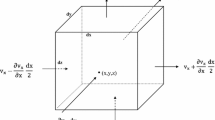Abstract
Degree of consolidation, U, is defined in two ways: (1) by settlement analysis and (2) by dissipation of pore pressure. Equations of vertical and radial consolidations are derived by equating the above two U. The new equations are compared with the existing equations of vertical and radial consolidations. It is shown that new equation of radial consolidation is exactly same as Barron’s equation of equal strain radial consolidation while in case of vertical consolidation it is similar to later part of Terzaghi’s equation of vertical consolidation. A few possible reasons and advantages of comparison are given. The theory of rapid loading methods is based on the equality of these two degrees of consolidations. It is concluded that in rapid loading methods the next load increment can be applied at any time in radial consolidation once the effects of initial compression are over. However, in vertical consolidation it can be applied only after 60% consolidation.


Similar content being viewed by others
References
Barden L (1965) Consolidation of clay with non-linear viscosity. Geotechnique 15(4):345–362
Barden L, Berry PL (1965) Consolidation of normally consolidated clay. J Soil Mech Found Div Proc ASCE 91(SM5):15–35
Barron RA (1948) Consolidation of fine grained soils by drain wells. Trans ASCE 113:718–724
Burland JB, Roscoe KH (1969) Local strains and pore pressures in a normally consolidated clay layer during one dimensional consolidation. Geotechnique 19:335–356
Cao LF, Chang MF, Teh CI, Na YM (2001) Back-calculation of consolidation parameters from field measurements at a reclamation site. Can Geotech J 38:755–769
Christie IF (1965) Secondary compression effects during one-dimensional consolidation tests, vol 1. In: Proceedings, VI international conference on soil mechanics and foundation engineering, Montreal, pp 198–202
Fox EN (1948) Mathematical solution for the early stages of consolidation, vol 1. In: Second international conference on soil mechanics and foundation engineering, Rotterdam, pp 41–42
Kim YS, Lee SR (2000) Prediction of long-term pore pressure dissipation behavior by short-term piezocone dissipation test. Comput Geotech 27(4):273–287
Leonards GA, Girault P (1961) A study of one dimensional consolidation test, vol I. In: Proceedings, fifth international conference on soil mechanics and foundation engineering, Paris, pp 213–218
Olson RE (1986) State of the art: consolidation testing. In: Yong RN, Townsend FC (eds) Consolidation of soils: testing and evaluation, ASTM STP 892, pp 7–70
Punmia BC, Jain AK, Jain AK (2008) Soil mechanics and foundations, 16th edn. Lakshmi Publications, India
Raymond GP (1966) Laboratory consolidation of some normally consolidated soils. Can Geotech J 3(4):217–234
Robinson RG, Soundara B (2008) Coefficient of consolidation from mid-plane pore pressure measurements. Int J Geotech Eng 2(4):419–425
Sridharan A, Nagaraj HB, Srinivas N (1999) Rapid method of consolidation testing. Can Geotech J/Rev Can Geotech 36(2):392–400
Taylor DW (1942) Research on consolidation of clays. Publication from Department of Civil and Sanitary Engineering, Serial 82, Massachusetts Institute of Technology, August, p 147
Taylor DW (1948) Fundamentals of soil mechanics. Wiley, New York, pp 238–242
Terzaghi K (1923) Mathematisch-naturewissenschaftliche Klasse, Akademie der Wissenschaften in Wien, Sitzungsberichte, Part Iia 132(3/4):125–138
Tewatia SK (1998) Evaluation of true Cν and instantaneous Cν, and isolation of secondary consolidation. Am Soc Test Mater Geotech Test J GTJODJ 21(2):102–108
Tewatia SK (2010) Time dependent behavior of clayey soils. PhD thesis, Department of Civil Engineering, Delhi College of Engineering, Delhi University, India
Tewatia SK (2011) Trend of settlement in primary and secondary consolidations. Geomech and Geo-engg, Taylor and Francis Publication (unpublished)
Tewatia SK, Bose PR, Sridharan A, Rath S (2007) Stress induced time dependent behavior of clayey soils. Geotech Geol Eng J 25:239–255
Tewatia SK, Sridharan A, Prakash K, Rath S (2011a) Comparison of vertical and radial consolidations. Int J Geomech, ASCE (unpublished)
Tewatia SK, Sridharan A, Phalswal MK, Gupta DK, Rath S (2011b) Fastest methods of vertical and radial consolidations. Int J Geomech (unpublished)
Theim A (1906) Verfahress fur Naturlicher Grundwassergeschwindegkiten: Polyt. Notizblatt, in 1887. 42:229
Vinod JS, Sridharan A, Indraratna B (2010) Determination of coefficient of radial consolidation using steepest tangent fitting method. Geotech Geol Eng J 28(4):533–536
Mesri G, Godlewski PM (1977) Time and stress-compressibility interrelationship. J Geotech Eng Div Proc ASCE 103(GT5):417–430
Author information
Authors and Affiliations
Corresponding author
Rights and permissions
About this article
Cite this article
Tewatia, S.K., Sridharan, A., Singh, M. et al. Theoretical Equations of Vertical and Radial Consolidation by Equating Degrees of Consolidation by Settlement Analysis and Dissipation of Pore Pressure. Geotech Geol Eng 30, 1037–1043 (2012). https://doi.org/10.1007/s10706-011-9485-y
Received:
Accepted:
Published:
Issue Date:
DOI: https://doi.org/10.1007/s10706-011-9485-y




